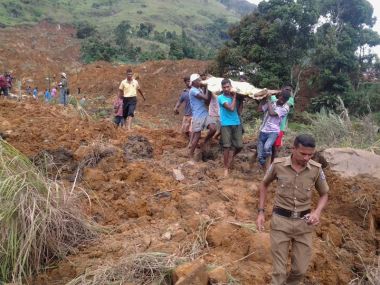No hope for survivors in Sri Lanka landslide, over 100 dead

Hopes of finding survivors under the mud and rubble of a landslide in south-central Sri Lanka had run out by first light on Thursday, though a government minister cut the estimated death toll to more than 100 from 300 the previous night.
"I don't think there could be any survivors," Disaster Management Minister Mahinda Amaraweera told Reuters, after visiting the disaster site in the tea-plantation village of Haldummulla, 190 km (120 miles) from the capital, Colombo.
"It is about 100 people who have been buried as there were some children and some estate workers who were not at their houses at the time of the disaster," he added, explaining why the death toll could be lower than feared the day before.
The Disaster Management Centre revised down its estimate for the number of people missing in Wednesday's disaster to 192 from 300. Amaraweera said it was difficult to be sure of the number because population data was lost in the landslip.
The centre said 150 houses were buried in the landslide, which stretched 3 km (2 miles) and engulfed the village after days of heavy monsoon rains.
Children who left for school before the earthfall returned to find their clay and cement houses had been buried. Nearly 500 people, most of them children, spent the night at a nearby school after warnings of further landslide.
At the disaster site, hundreds of soldiers and government officials resumed search and clearing operations, using three earth-moving machines that rumbled amid broken trees, blocks of concrete, tin roofing and muddied clothes.
Residents, many of them tea plantation workers, said as well as their homes, the area included a playground, a small shopping complex and a Hindu temple.
Many people in the hilly area are of Indian Tamil origin, descendants of workers brought to Sri Lanka under British rule as cheap labour to work on tea, rubber and coffee plantations.
'STILL WAITING'
In a nearby school, stunned survivors wept.
"I am still waiting for my daughter and her husband," Ramalingam, 60, said, tears rolling down his cheeks.
"They were at their house in the 10th line and all the houses in that line are buried. Their son is alive because we took him to pre-school yesterday."
Vansanthi Kumari, a mother of three, lost her six-year-old daughter.
"My daughter and eight-year-old son went together to school. My son survived in a tree, but I've lost my daughter," she wailed. "We have found her body and it is in the hospital. I don't have a place to keep her body."
She said authorities had given no warning of a landslide threat though some officials had encouraged her family to leave the area three years ago, but had offered no alternative.
Kelum Senevirathne, a geologist with the National Building Research Organisation, said the area had been identified as landslide-prone and the villagers had been informed.
"Since the disaster, our officers have observed some cracks on the upper side of the land. So there is a risk of further landslides," Senevirathne told Reuters.
Disaster Minister Amaraweera said villagers had been advised in 2005 and 2012 to move away but many did not heed the warnings.
There have been a number of landslides since the onset of heavy rains in mid-September resulting in damage to roads, but there had been no casualties until Wednesday.
(Reuters)











